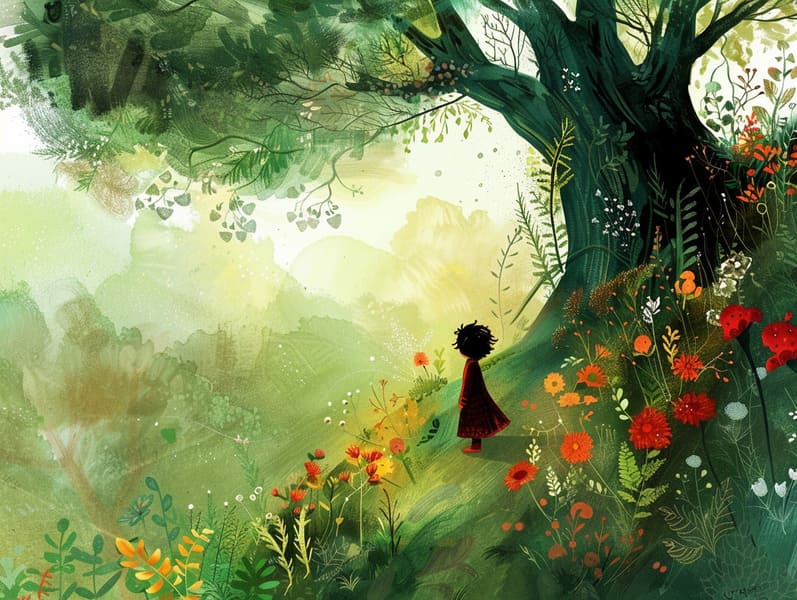The Emergence of Mythical Fairy Tales with the Undying Wonder.

Children's fairy tales have old origins. These tales have been conveyed from one generation to the next well before they were ever put on paper. They developed from a variety of civilizations, including American traditions. They were initially shared among adults, often carrying themes and messages reflective of the societal norms and beliefs of the time.
The Grimm brothers, Jacob and Wilhelm Grimm, were among the first to compile and publish many of these beloved stories. Their volume, "Grimm's Fairy Tales," included classics like "Cinder Maid," "Hansel and Gretel," and "Little Snow White," which have since become mainstays in the world of timeless fairy tales. Similarly, H. C. Andersen's whimsical tales, such as "The Mermaid," and "The Duckling's Story," have gained the love worldwide, establishing their place in the pantheon of timeless fairy tales.
Though they are old, these stories remain as significant as ever, especially as kids' bedtime tales. These magical stories are now available in many formats, including gorgeously illustrated books, magical animations, and online storybooks.
Their persistent charm can be credited to several enchanting factors:
Vital Lessons: Timeless fairy tales often provide important moral lessons. Stories like "The Shepherd Boy and the Wolf" teach the virtue of sincerity, while "The Hare and the Tortoise" emphasize the traits of perseverance and modesty. These narratives offer little ones clear distinctions between good and bad, molding their moral compass in a gentle yet profound way.
Compassion and Insight: Timeless fairy tales frequently portray characters facing struggles and tests, provoking children to identify with their struggles and root for their triumphs. For instance, "Beauty and the Beast" points out the benefit of seeing beyond the surface to know the inner core of a individual, advancing kindness and appreciation.
Cultural Understanding: Many traditional fairy tales are deeply ingrained in the cultural contexts from which they arose. Delving into these tales can provide enlightening views into different ways of life, developing a sense of cultural respect and perception.
Creativity and Imagination: The extraordinary elements in ancient fairy tales—enchanted lands—unleash children’s innovative ideas. These narratives guide readers to mythical realms, enhancing creative ideas and a sense of astonishment that lasts a lifetime.
Classic fairy tales are not only magical but also enlightening. They act as fantastical tools in fostering various cognitive and emotional skills in young ones. When classic fairy tales are read aloud, they cultivate verbal development by showing new linguistic elements and elaborate sentence structures. This practice also nurtures hearing perception and attentiveness, as young ones stay focused, anticipating to see what happens next.
Furthermore, contemplating the themes and characters of old fairy tales can develop thinking skills and logical thinking. Kids are shown to discern patterns, make predictions, and understand cause and effect. These examinations also contribute to kids communicate their thoughts and feelings, adding to their emotional intelligence.
In today’s technological era, the presence of internet fairy tales has made these tales more acquirable than ever. Online resources and apps feature wide arrays of popular fairy tales that can be perused or heard anytime, anywhere. Fairy tales spoken are particularly prevalent, sharing an engaging way for young readers to take part in these alluring stories. Narrated books and read-out-loud stories move characters and settings to life, often augmented by delightful soundtracks and melodies that raise the narrative adventure.
The unending appeal of traditional fairy tales lies in their ability to modify to modern times while holding onto their core messages. Contemporary versions of these fairy tales often present more diverse figures and modern settings, making them accessible to today’s audience. However, the core values of daring, kindheartedness, and justness remain unchanged, continuing to affect young listeners of all ages.
Ancient fairy tales also offer a sense of serenity and knowability. They impart a structured narrative with a straightforward beginning, middle, and end, often ending with the resolution of conflicts and the triumph of morality over immorality. This certainty can be solacing for little ones, spreading a sense of sturdiness in an always shifting world.
Old fairy tales continue to charm and enlighten new generations, maintaining their grace and value in modern society. As bedtime stories for kids, they present to a perfect blend of enchantment and education, enriching moral values, empathy, and creativity. The abundance of online fairy tales and the favor of fairy tales narrated validate that these classic narratives remain attainable to new generations.
By continuing and relating these tales, we continue this site to honor the rich tapestry of cultural legacy and cultural heritage. Whether you are viewing a richly illustrated book, viewing a digital library, or listening to an sound book, the elegance of bedtime fairy tales is always within reach. These narratives highlight of the lasting strength of narratives and its ability to bring us together across epochs and places.
No matter if you are delving into a vividly illustrated book, accessing a web-based library, or listening to an audiobook, the beauty of bedtime fairy tales is always within reach.
These narratives demonstrate of the consistent essence of tales and its ability to tie us across time and space, forming a connection that captivates and teaches alike.